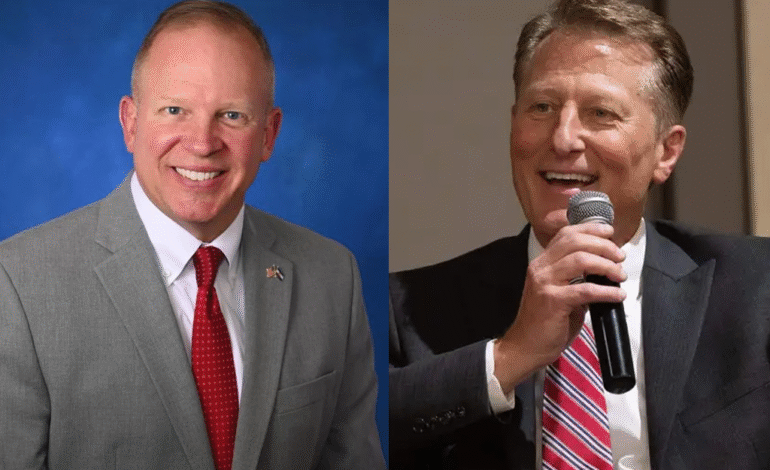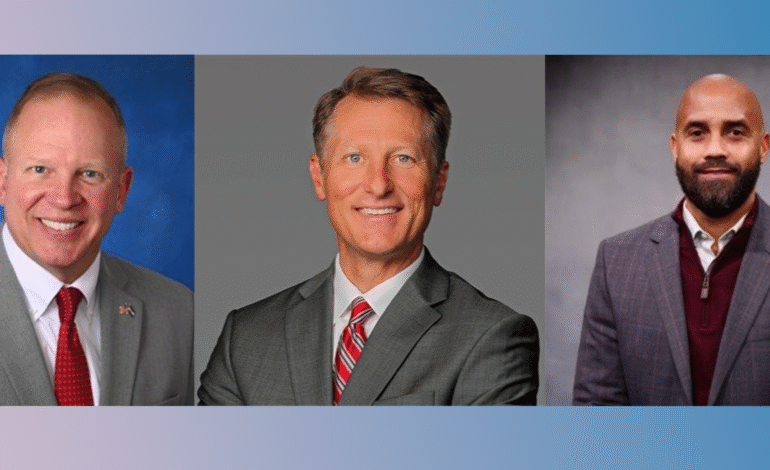
Wichita’s Biomedical Campus: A New Horizon for Health, Education, and Downtown Revitalization
Introduction: A New Era for Downtown Wichita’s Health Landscape The Wichita Biomedical Campus (WBC) is poised to redefine healthcare education, research, and technology across Kansas. This ambitious, multi-institutional partnership, spearheaded
Introduction: A New Era for Downtown Wichita’s Health Landscape
The Wichita Biomedical Campus (WBC) is poised to redefine healthcare education, research, and technology across Kansas. This ambitious, multi-institutional partnership, spearheaded by Wichita State University (WSU), the University of Kansas (KU), and WSU Tech, represents a significant investment in the state’s future, with an estimated total cost ranging from $300 million to $302 million. Strategically located in downtown Wichita, this campus is designed to be a prominent center for cutting-edge research, advanced medical technologies, and comprehensive education, drawing an anticipated influx of 3,000 students and 200 faculty and staff to the urban core.
This project marks a historic collaboration between three major academic institutions: WSU, KU, and WSU Tech. Their collective vision extends beyond simply co-locating programs; it aims to create a dynamic “healthcare corridor” in downtown Wichita. This corridor is intended to foster deep collaboration, support interprofessional learning, and catalyze partnerships in new and emerging research fields. The project’s strategic placement and design underscore a broader urban planning approach. The influx of students and faculty downtown, coupled with the explicit goal of the WBC serving as a “catalyst for downtown Wichita’s revitalization” and a “vibrant hub” , indicates a deliberate strategy. This approach leverages a major educational and research facility as an anchor to stimulate broader urban development. It is not just about a new building but a conscious decision to transform downtown into a multi-functional “healthcare corridor”. This signifies a shift in downtown’s identity, moving beyond traditional business districts to become a dynamic live-work-learn environment, creating a self-reinforcing cycle where academic excellence fuels economic vitality and vice-versa.
Upon full completion across all planned phases, the total campus is envisioned to encompass approximately 471,000 square feet. The initial phase, Phase 1, is a $222 million, 350,000-square-foot joint health sciences center located at the southeast corner of Broadway and William. Construction is anticipated to be complete by the end of 2026, with the first cohort of students potentially starting classes in Spring 2027.
Wichita Biomedical Campus at a Glance
| Feature | Detail |
| Total Estimated Project Cost | $300M – $302M |
Export to Sheets
From Parking Lot to Progress: The Site’s Past
The chosen site for Phase 1 of the Wichita Biomedical Campus, specifically the southeast corner of Broadway and William, reflects Wichita’s evolving urban landscape. Before the groundbreaking for this monumental project, the land served a rather utilitarian, yet essential, purpose: it was a parking lot. This transformation from a space primarily dedicated to vehicle storage to a cutting-edge biomedical hub symbolizes the city’s forward momentum and its commitment to innovation and progress.
While the immediate construction site was a parking lot, the broader intersection of Broadway and William has a rich architectural history. For instance, the Brown Building, completed in 1927 and expanded in 1928, stands at 105 South Broadway, near the corner. This eleven-story Commercial style office building, adorned with Classical Revival details, is nominated to the National Register of Historic Places, showcasing the area’s early 20th-century development. Further emphasizing the historical context, the Twentieth Century Club Building, an 1887 Queen Anne structure with later brick additions, is located at the southeast corner of Broadway and Elm, a nearby intersection. This building, originally Judge Sankey’s residence, later became a club and theater, reflecting the area’s social and cultural evolution. These historical structures provide a backdrop of a vibrant, developing downtown, highlighting that the new campus is being built within a historically significant urban fabric. The decision to build the WBC on a previously underutilized parking lot, rather than demolishing a historic building like the Brown Building or the Twentieth Century Club, represents a deliberate strategy of urban infill. This approach minimizes disruption to existing historical architecture while maximizing the use of underutilized space. It reflects a modern approach to downtown revitalization that balances new development with historical preservation, rather than a tabula rasa approach. The contrast between the architectural grandeur of past structures and the utilitarian nature of a parking lot underscores the transformative nature of the WBC project, shifting from a space that facilitated movement
through downtown to one that encourages gathering, learning, and staying in downtown, thereby enhancing the urban experience and value.
Phase One Takes Shape: A Hub of Innovation and Learning
The initial phase of the Wichita Biomedical Campus is rapidly taking form, anchored by an eight-story tower. This foundational structure, costing $222 million, encompasses 350,000 square feet. It is meticulously designed to accommodate a substantial academic community, with capacity for up to 3,000 students and 200 faculty and staff.
The building’s architectural vision prioritizes both functionality and aesthetic appeal. It features a distinctive stair-stepped silhouette, complemented by terra cotta paneling and glass bands, aiming for a modern visual presence while maximizing natural light. This design draws inspiration from the unique geology of the Flint Hills, incorporating “hidden gems” like lounges and exterior patios that offer breathtaking views of the city. A prominent three-story street-facing pavilion will provide flexible space, including three 80-seat classrooms that can be converted into event spaces, and an outdoor terrace on its roof for student and community gatherings. The architectural firms Helix Architecture + Design and CO Architects are the creative forces behind this vision.
The campus is designed to bring together a wide range of health-related programs under one roof, fostering an environment of interdisciplinary work and collaboration. These include Wichita State University’s College of Health Professions, which encompasses its Speech-Language-Hearing Clinic. WSU Tech’s nursing and surgical technology training programs will also be integrated , alongside the University of Kansas’ medical and pharmacy schools.
The tower’s interior is meticulously designed to promote interprofessional learning, envisioned as a series of “vertically stacked communities and neighborhoods”. This design philosophy aims to foster collaboration by breaking down traditional academic silos. Shared features include a state-of-the-art simulation center, an anatomy lab, and various high-tech classrooms. Wichita State and WSU Tech will share the first four stories of the building. The fifth floor is dedicated as a shared simulation floor, equipped with flexible simulation rooms, including a 1,000-square-foot four-bed room with a movable wall, and six 425-square-foot two-bed rooms. This floor also features a control room for faculty observation, a 30-seat simulation classroom, and five 12-student debriefing rooms. The University of Kansas will utilize the top three stories for its classrooms, workspaces, and offices. KU’s dedicated spaces will include a 24-room Standardized Patient Center on the sixth floor for clinical skills training, two 40-person classrooms, two Point of Care Ultrasound (POCUS) training rooms, and a model pharmacy and clinical skills lab. By having students from different health professions—such as doctors, nurses, pharmacists, speech-language pathologists, and surgical technologists—learn and train in these shared, high-tech environments, the campus aims to cultivate a truly “interprofessional health care learning” experience. This directly addresses the critical need for better team-based care in modern healthcare, ultimately leading to improved patient outcomes. The design itself functions as a pedagogical tool, fostering a collaborative mindset from the earliest stages of professional training.
Construction for Phase 1 officially began in spring 2024 , with an official groundbreaking ceremony held on May 8, 2024. Site work was well underway by October 2024 , and crews began breaking ground by July 2024. Completion is anticipated by the end of 2026 , with the first class of students expected to begin training in the new building in Fall 2027. This project is not merely an academic expansion but a direct, large-scale response to a critical statewide need. Multiple sources explicitly state that the project aims to “address workforce shortages in nursing, primary care, and other healthcare specialties” and “fuel the talent pipeline with highly trained health care professionals”. By centralizing and integrating training for diverse programs, the campus can more efficiently produce a skilled healthcare workforce, potentially reducing brain drain and attracting new talent to Kansas. The emphasis on “applied learning” and “real-world, hands-on training” further ensures graduates are job-ready, directly impacting the quality and availability of healthcare services across the state. This proactive approach aims to future-proof Kansas’s healthcare system against evolving demands and crises.
Investing in Kansas’s Health: Funding the Biomedical Vision
The Wichita Biomedical Campus represents a substantial financial commitment, with a total estimated cost of $300 million to $302 million. Phase 1 alone is budgeted at $222 million. This significant investment is being realized through a diverse funding model, combining substantial state appropriations with crucial private contributions.
The Kansas Legislature has been a major contributor to the project, allocating $190 million, which included American Rescue Plan Act (ARPA) dollars. An additional $15 million came from the Kansas Department for Aging and Disability Services (KDADS) through the Strengthening People and Revitalizing Kansas (SPARK) Executive Committee and State Finance Council. A more detailed breakdown of the $205 million total state funding includes $10 million from the State General Fund, $25 million from ARPA, an additional $142 million from ARPA, $13 million from the State General Fund, and $15 million from SPARK. It is important to note a reported error where ARPA funding was cut in half, subsequently replaced by $30 million in State General Fund money, resulting in a net loss of $41 million from anticipated support. Despite this, the state’s commitment of $205 million remains substantial and critical to the project’s advancement.
Private funding also plays a vital role, particularly for specific components of Phase 1. Blue Cross and Blue Shield of Kansas (BCBSKS) made a lead gift of $2.5 million in February 2025. Of this, $1.8 million is earmarked directly for the campus, specifically to ensure clinical space is included in the Phase 1 construction. The remaining $700,000 from the BCBSKS gift funds two endowed nursing scholarships. The total private fundraising goal for Phase 1, specifically for the relocation of the Evelyn Hendren Cassat Speech-Language-Hearing Clinic to the new campus, is between $16 million and $17 million. The $1.8 million from BCBSKS contributes significantly to this remaining private project cost. Additionally, the Kansas Health Foundation provided seed money for initial planning. WSU’s fundraising arm, the Wichita State Foundation, is actively involved in securing these crucial private contributions.
The project’s funding clearly demonstrates a significant reliance on both state appropriations and private philanthropy. This collaboration is explicitly called out as a “model for how Kansas Board of Regents institutions can work together with state and local governments”. This multi-source funding model mitigates risk for any single entity and effectively leverages different strengths: public funds for foundational infrastructure and strategic alignment, and private funds for specialized facilities, scholarships, and accelerating completion. It underscores a shared belief across sectors in the project’s long-term value for Kansas, indicating strong political and community buy-in. The BCBSKS donation, specifically for clinical space and scholarships, highlights how private partners are directly investing in the applied learning model and workforce development goals, aligning their corporate social responsibility with state strategic objectives. The fact that the project is moving forward despite a significant funding adjustment, such as the $41 million loss from anticipated ARPA funding, speaks to the robustness of its overall financial planning and the high priority placed on its completion by state and institutional stakeholders. This demonstrates financial resilience and a strong commitment to the project’s success.
Funding Sources for the Wichita Biomedical Campus
| Category | Source | Amount / Goal | Notes |
| Total Project Cost | Overall Estimate | $300M – $302M | For the entire multi-phase campus |
| Phase 1 Cost | Budgeted for initial construction | $222M | |
| State Funding (Total $205M) | Kansas Legislature (incl. ARPA) | $190M | |
| KDADS (SPARK) | $15M | Through Strengthening People and Revitalizing Kansas Executive Committee and State Finance Council | |
| State General Fund (specific) | $10M + $13M | Specific allocations within state funding | |
| American Rescue Plan Act (ARPA) (specific) | $25M + $142M | Note: $41M loss from anticipated ARPA funding due to legislative error | |
| Private Contributions (Key Examples) | Blue Cross and Blue Shield of Kansas (Total Gift) | $2.5M | First philanthropic contribution to the project |
| – Earmarked for Campus (clinical space) | $1.8M | Contributes to remaining $16M Phase 1 project cost | |
| – Nursing Scholarships | $0.7M | Funds two endowed nursing scholarships | |
| Private Fundraising Goal (Speech-Language-Hearing Clinic) | $16M – $17M | For relocation of Evelyn Hendren Cassat Speech-Language-Hearing Clinic to new campus | |
| Kansas Health Foundation | Seed Money | For initial planning of the project |
Beyond Education: Driving Research and Medical Advancement
The Wichita Biomedical Campus is designed to be more than just a teaching facility; it is envisioned as a dynamic hub for cutting-edge research, innovation, and medical technology development, directly impacting patient care and the state’s healthcare landscape. The campus emphasizes blending classroom instruction with real-world, hands-on training. It fosters an environment where researchers, healthcare professionals, and industry leaders can collaborate to drive groundbreaking discoveries. This interdisciplinary approach is crucial for addressing complex health challenges and advancing medical technologies.
Several key research initiatives and centers are planned for the WBC. The Institute for Rehabilitation Medicine and Assistive Technology (IRMAT), launched by Wichita State in November 2024, will be housed within the WBC starting in 2027. IRMAT focuses on patient-driven research and development of innovative technologies for individuals with physical and cognitive disabilities. Its collaborations include Ascension Via Christi’s Rehabilitation Hospital, Heartspring’s Outpatient Services, and the Robert J. Dole VA Medical Center. This institute leverages WSU’s existing strengths in engineering and technology, creating a powerful synergy between academic research and clinical application.
Another significant development is a $1 million grant supporting the purchase of advanced audiology equipment. This equipment will directly benefit Doctor of Audiology and Master of Arts in speech-language pathology students, and will support Wichita State’s Evelyn Hendren Cassat Speech-Language-Hearing Clinic, which is slated for relocation to the campus. This clinic also serves as a vital clinical training and research laboratory for graduate students, providing invaluable hands-on experience. Furthermore, the Kansas Center for the Advancement of Healthcare (KCAH) will have a Wichita presence within the WBC, aiming to develop a systematic approach to healthcare across the state through collaborative efforts. Wichita State is also exploring the feasibility of establishing the first dental school in Kansas within the WBC, a move that would address statewide dental care gaps and attract new talent to the region.
While the broader campus focuses on health sciences, Wichita State’s existing Biomedical Engineering department highlights specific research areas that align with the WBC’s mission and could be further integrated. These include musculoskeletal biomechanics, human movement computer simulation, rehabilitation engineering and technology, functional electrical simulation, neuromuscular control, and human movement coordination. Research also extends to novel quantitative approaches for medical diagnostics and treatment monitoring through mathematics, computational medicine, bioinstrumentation, and biomedical sensor design, encompassing areas like RF resonators, wearable sensors, intracranial pressure, muscle damage quantification, Raman spectral analysis, hyperspectral imaging, and biomechanical instrumentation design. Further areas of focus include mechanics and materials for flexible and stretchable electronics, real-time health monitoring with automated analysis, wearable biosensors, and human-machine interfaces. The campus will also facilitate research in cardiovascular mechanobiology, cell-tissue biophysics, instrumentation/devices to understand cell and tissue mechanobiology, identifying novel surrogate markers of diseases, gene regulation, epigenetics, cell and tissue engineering, and regenerative medicine. Neuroimaging data analysis, optical neuroimaging design, human subject motor learning studies, and machine learning are also prominent areas. Finally, the modification and surface engineering of biomaterials, biocompatible polymers for bioprinting and additive manufacturing of medical devices, and biodegradable metals for bone tissue engineering, cardiovascular, and other applications are key research thrusts. General biomedical engineering research areas include biomaterials and biomechanics, bioimaging/molecular imaging, tissue engineering/regenerative medicine, bionanotechnology, molecular biomedical engineering, medical instrumentation, and biomedical modeling.
Wichita State University has a dedicated Technology Transfer and Commercialization office that actively works to move innovations from research into practical applications, including new license agreements and partnerships. This existing infrastructure supports the commercialization of discoveries made at the WBC, fostering an environment where research translates into real-world solutions and economic opportunities. This signifies a strategic intent to create a complete innovation pipeline within the biomedical sector in Wichita. It is about translating research into tangible medical technologies, products, and improved patient outcomes, which can attract industry partners, create high-value jobs, and diversify the Kansas economy. The potential dental school further expands this innovation ecosystem into a new, underserved area, demonstrating a commitment to comprehensive healthcare solutions.
Beyond simply increasing the number of healthcare professionals, the WBC has a critical mission to address health equity and access challenges across Kansas, particularly in rural and underserved areas. The BCBSKS nursing scholarships, for example, specifically target students from “any Kansas county other than Johnson, Wyandotte or Sedgwick counties”. The School of Nursing has expressed gratitude for support in “enhancing workforce development in rural and underserved areas of Kansas”. By training professionals who may return to these regions and by fostering research initiatives like KCAH that consider statewide needs, the campus aims to improve overall health outcomes for all Kansans, not just those in urban centers. This adds a significant social impact dimension to the project, positioning it as a force for equitable healthcare distribution.
A Catalyst for Growth: Economic and Community Impact
The Wichita Biomedical Campus is heralded as a transformative project with profound economic and community development implications for downtown Wichita and the entire state of Kansas.
The project is expected to provide a direct economic boost to downtown Wichita. The campus will bring an estimated 3,000 students and 200 faculty and staff downtown. This significant increase in population will drive “increased foot traffic for local businesses, restaurants, bars and retail establishments” , creating a vibrant street-level economy. While specific long-term job creation numbers are not explicitly stated for the WBC alone, the project is seen as a strategic investment to boost Kansas’s healthcare workforce. The general tech sector in Wichita is projected for substantial growth, with 18-20% growth and 15% job growth anticipated by 2033 , and the biomedical campus will contribute to this by creating high-value job opportunities. The construction phase itself provides a one-time economic boost, generating approximately 16,551 temporary jobs. Moreover, the campus has already sparked additional health-related private development downtown. Sedgwick County purchased three properties for COMCARE Crisis services, and Heartspring acquired two buildings for pediatric neurodevelopment outpatient services, both adjacent to the campus. This demonstrates a clear ripple effect of investment, validating the campus’s role as an economic anchor.
The WBC is a cornerstone of downtown Wichita’s ongoing revitalization efforts, transforming it into a “prominent center for cutting-edge research, advanced medical technologies, and high-value job opportunities”. It contributes significantly to the “healthcare corridor” vision, strategically situating healthcare services, education, research, and technology near existing private hospitals and providers. This concentration enhances partnerships and fosters innovative research. The project aligns with “Project Downtown: The Master Plan for Wichita,” which has guided over $1.7 billion in investment since its adoption in 2010. The WBC is explicitly an example of urban infill, addressing a key area of focus for this plan. The residential base of downtown has more than doubled since 2010, and the office and hospitality markets have grown; the WBC will further support these trends through increased demand for housing, services, and entertainment. The campus contributes to downtown being recognized as a destination, attracting regional and global headquarters, and enhancing the city’s overall image and appeal.
Wichita State University has a successful “Innovation Campus” model that involves public-private partnerships, co-locating companies on campus, and collaborating on research and product development. The WBC, with its emphasis on industry partnerships , applied learning , and attracting private development , appears to be applying this successful “Innovation Campus” strategy to the healthcare sector, specifically in downtown Wichita. This suggests a proven framework for economic development is being deployed. The WBC is not a standalone project but part of a broader, successful institutional strategy to integrate academia with industry for economic growth and talent retention. This increases the likelihood of long-term success and sustained economic benefits for Wichita and Kansas, as it builds on established mechanisms for collaboration and commercialization, making it a more reliable investment for future growth.
The economic benefits of the WBC extend beyond direct financial metrics to improving the overall quality of life and attractiveness of downtown Wichita. While job creation and investment are clear economic benefits, the campus also fosters a “sense of familiarity, community, and purpose for all who enter its doors” and creates “flexible community areas”. The influx of students and faculty contributes significantly to downtown’s vibrancy. The overall goal is to attract and retain talent. A vibrant, walkable downtown with educational and community amenities becomes a draw for a skilled workforce and their families, creating a positive feedback loop for further economic development. This holistic approach to urban development recognizes that talent is attracted not just by jobs, but by dynamic and livable communities that offer a high quality of life and a sense of belonging.
The campus also aims to address workforce shortages in nursing, primary care, and other healthcare specialties across Kansas. It is seen as a strategic investment in Kansas’s healthcare workforce, improving education outcomes. The high-tech facility is expected to attract and retain talent and resources to the Wichita area, boosting the economic success of the entire state. Wichita State University’s overall economic impact in Kansas in 2021 was $1.3 billion, and the WBC is a significant new contributor to this, demonstrating the university system’s role as an economic driver for the state.
The Road Ahead: Future Phases and Long-Term Vision
The Wichita Biomedical Campus is conceived as a multi-phase project, with Phase 1 laying the groundwork for significant future expansion and a long-term vision to solidify Wichita’s position as a national healthcare leader.
While Phase 1 is currently underway at the southeast corner of Broadway and William, future phases are already planned for 214 S. Topeka. This site is currently home to the Wichita Transit Center, which is slated to relocate to the Delano neighborhood. The total projected square footage for the entire campus, including these future phases, is approximately 471,000 square feet. Plans and funding for these subsequent phases have not been finalized, but they are expected to bring the campus to its full projected size. This phased approach allows for flexibility and responsiveness to changing needs, funding availability, and market demands. It enables the project to begin and demonstrate initial success with Phase 1 before committing fully to subsequent, larger investments. This is a pragmatic strategy for large-scale urban development, ensuring sustainability and adaptability rather than a rigid, all-at-once construction. It also allows for lessons learned from Phase 1 to inform the design and execution of future expansions, optimizing resource allocation and project outcomes.
The campus is strategically designed for future expansion, allowing for the growth of existing programs and the addition of new degree programs and research projects. The overall vision is to create a thriving healthcare corridor in downtown Wichita, where medical services, education, research, and technology can intersect with private hospitals and healthcare providers. The WBC aims to “transform healthcare education, address workforce shortages, drive biomedical innovation, and serve as a catalyst for downtown Wichita’s revitalization”. It is expected to significantly increase the number of physicians trained at KU School of Medicine, with an intent to increase class sizes to up to 70 students per year in Wichita. The project is seen as a model for inter-institutional and governmental collaboration to advance economic development. Ultimately, the campus is poised to become a cornerstone of Wichita’s downtown revitalization and a model for health care education and research, improving the lives of countless individuals across Kansas.
While the project is physically located in downtown Wichita, its stated goals consistently extend to “the entire state in health care and health care education” , “improving patient outcomes for all Kansans” , and “enhancing workforce development in rural and underserved areas of Kansas”. The KCAH initiative and the potential dental school further underscore this statewide ambition. This positions the WBC not just as a local asset but as a critical piece of Kansas’s statewide healthcare infrastructure and economic diversification strategy. Its success will have ripple effects on healthcare access, quality, and economic vitality far beyond Wichita’s city limits, potentially attracting talent and investment to the entire state. This elevates the project from a municipal development to a key state-level strategic initiative, demonstrating a commitment to the well-being of all Kansans.
Conclusion: A Bold Step Forward for Kansas
The Wichita Biomedical Campus stands as a testament to the power of collaborative vision and strategic investment in the heart of Kansas. From its origins as a downtown parking lot, this estimated $300-$302 million multi-phase project is rapidly transforming into a cutting-edge hub for health education, research, and technological advancement. This historic partnership between Wichita State University, the University of Kansas, and WSU Tech is more than just a new building; it is a deliberate, multi-faceted commitment to addressing critical healthcare workforce shortages, fostering interdisciplinary innovation, and revitalizing downtown Wichita.
As Phase 1 nears completion by late 2026, welcoming its first students in Fall 2027, the campus promises an influx of talent and activity that will ripple throughout the local economy and improve health outcomes for all Kansans. With future phases already envisioned, the Wichita Biomedical Campus is poised to be an enduring model of how academic institutions, government, and private partners can unite to build a healthier, more prosperous future for the state, extending its positive influence far beyond the city limits.









